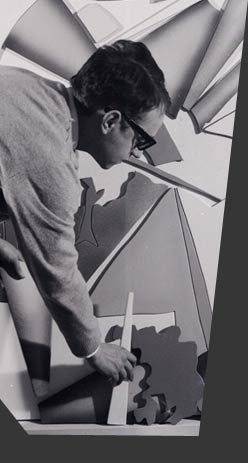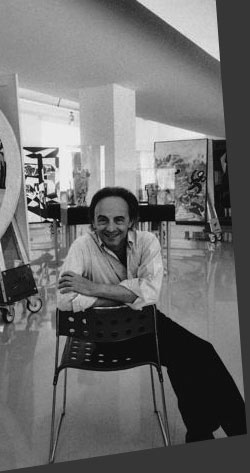Vittorio Fagone
IL MUSEO, IN THE MUSEUM
J.P. Gaudibert in his "Action culturelle" has written about large museums: "some private products of our environment, towns and streets become monstrously ART, works of art, masterpieces for and inside the museums; one arrives even at marketing certain objects exclusively for it. On the other hand, what is not in the museum or fit for inclusion in it, does not benefit from the label "legitimate".
This "art of the museum" risks being art completely separated, the idol of a new cultural religion; the gap between art and society is also to be found in museums, in traditional ones at least. But there is a special relationship - in this age which, according to the American art expert Max Kozloff may be called "the age of the museum" - between the avant-garde and the museum. The function of the museum, and certainly the most desired task, in Kozloff's opinion is that of "perpetuating the avantgarde ", of performing the myth of the eternal renewal of the visual arts. In this sense, Kozloff suggests that there is a parallel between the museum function of promoting the avant-garde and the role of symphonic orchestras in the nineteenth century.
The growth of the museum is related to the necessity of the affirmation, consecration and diffusion of certain types of work. Nespolo, when making this painting (which in complexity and sheer size can neither be places in a private gallery, even less in collector's home), was aware that he was making a museum-piece. In this work was offered both a pleasant and an irreverent image of the museum as the holy temple of the avant-garde. If we look at the iconography of the painting as a whole it will appear like an inflated domestic environment. The table dining-room lamp-shades am in contradiction to the "zenithal" light, typical of new museums, the dog on the lead, children, the man with a stick, the man with a coat, are all improbable characters in avant-garde museums, whether small or large. Even more improbable is the height of the required room and, above all, the sizes of the paintings, reduced to the dimensions of "plein air" works.
Avantgarde painting is huge like this. But the characteristics of the painting brought together in this work reduces everything to the size of a" Musée de chambre ", hardly larger than "Musée de poche" reproductions. Naturally, the greatest contradiction is in the kind of transformation which these " monuments " of international avant-garde art undergo; counterfeit copies, enlargements of insignificant details, copies of non-existant paintings (clever variations) are all included in a madeup game, which forces us to read first the manufact and then the image or negation of. What as an operation does it mean?
Identity anti recognition.
Nespolo's painting could be used as a curious culture-quiz. Having established the 21 points of references, the observer would be given a rating according to the number of artists he is capable of identifying. Upwards to five points indicating a basic knowledge of contemporary art, up to ten good, and over fifteen " expert knowledge ", as three of four of the names have not the universal reputation of artists of international status. The recognition game, nevertheless, may also prove that contemporary artists need to present an image of themselves which is easily identifiable and repeatable, within a given direction, according to the market demand.
The price paid by conditioning of this kind being probably that the creative identity, stifled by repetition, becomes immobilizing - even Morandi did not paint bottles all the time.
The sequence.
The sequential order of these 21 pieces is by no means casual. This is neither a historical succession nor a division according to nationalities or trends. in the tradition of "Venice" or "Kassel".
But an order does exist, and it is elementary, compositional: a game of formats, presences, with an odd central perspective. The effect is also to demonstrate that an avantgarde always has a past-present complexion, an extremely fast rate of affirmation and diffusion, so that new work is not only seen immediately, but also apprehended.
On the other hand, in the play of inlays the spectator close-up to the paintings may establish sizes and distances in an anonymous parallel sequence.
Materials and connections.
We cannot ignore the amount of patient craftsmanship: the use of different materials corresponding to different technical abilities, the mixture of apparently incompatible media: inlays, embroidery, lacquering. The emphasis on the manual aspect of the work has a precise meaning, the rediscovery of the area of execution, a dimension which contemporary art has parted in the last ten years, by reviving the old classical prejudices towards "mechanical art".
Here however it is the mechanism which exudes a modern poison, corrosive power of its own.
Transpositions.
The photographed page of a dictionary, presented by Kosuth to the public's keen attention as a space for conceptual reflection, may lose sense from frequent repetition (and imitation). In Nespolo's embroidered imitation, this page is no longer a sum of explicit meanings, it reverts to a complex physicality becoming a series of signs organized in a way which is not separated from its physical aspect.
The operation of transposition, multiplied in each of the 21 works, by means of one of the oldest and elementary decorative techniques (embroidery) confers a primitive poignancy on these works. The reproduction of well-known works, with some malicious intent perhaps, may be similar to cushions with Millet's âAngelus" reproduced in needle-work in the nineteenth century.
In what kind of society do these objects function? Nespolo leaves this question open.
Contradictions and dialectic.
Nespolo has been debunking avant-garde methods for years but without falling into a regressive tendency; he is, on the contrary, trying to proceed further in two directions, which are characteristic of today research: that of innovation in a field of significant images, and the opening up of a direct space for social communication. He is criticising the avantgarde but at the same time he is absorbing its processes, its possibility of expansion, the vital repercussions over a wide area.
This behaviour is perhaps contradictory: Nespolo belongs, in his polemical approach, to the most vital section of the Italian avant-garde, if this appellation is still meaningful. What is certain is the liveliness of his dialectical thinking around both the models and utopies of contemporary research. Furthermore, in work of this kind, which demystifies the museum, the contradiction is open to a further extension, in so far as it cant have any location beyond the museum.
A different answer.
The suggestion we made so far is one of the possible hypothesis for interpreting such a work and which opens up many other stimulating non-parallel ways. We advise the reader to follow Nespolo" s creative game and look for them. On the other hand, this painting has got the power to cancel the text. Bataille wrote: "le tableau efface le texte".
Nespolo's "Il Museo" has also this charm.
(From the book: Nespolo, Giulio Bolaffi Editore, Biblioteca Bolaffi dei Contemporanei/2, Torino, 1979)



